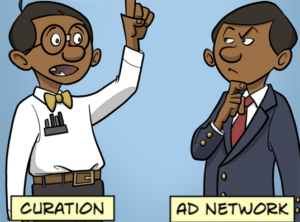 Since the beginning of the year, the Financial Times has been selling time-based ads, where the advertiser pays only for ads that have spent five seconds in view. It charges based on cost per hour (CPH).
Since the beginning of the year, the Financial Times has been selling time-based ads, where the advertiser pays only for ads that have spent five seconds in view. It charges based on cost per hour (CPH).
The Times decided to charge for an ad after five seconds because data from its viewability provider, Chartbeat, showed “that was the tipping point for when it became valuable or made an impact on the reader,” said the publisher’s US commercial director, Brendan Spain.
After five seconds, the FT saw lift in ad recall, brand recognition, brand association and brand consideration.
CPH pricing also plays to the Financial Times’ strengths. It publishes in-depth articles that are read thoroughly by its readership of high-income business leaders. The news publication has scale, but its real strength is its audience quality and engagement.
Although 15 of its advertisers have signed, it’s been an uphill battle to educate brands, since charging based on CPH requires brands to move away from metrics like click-through rates.
“Often times we get these RFPs that say, ‘We want to increase recognition as leader in consultancy space,’ and the KPI is click-through rate,” Spain said.
The Times tries to help brands point to higher-level results instead of click-through rates. It includes brand surveys for all advertising packages running on a CPH basis.
But that doesn’t make it easier for agencies to report on these campaigns.
“Agencies don’t have a slot on their Excel sheet for cost per hour,” Spain said. “It gets back to driving success for the client – because if it does [have such a slot], we should rethink what that spreadsheet looks like.”
Deals have been stalled precisely because of the Excel issue. One agency simply used an asterisk in the CPC column for its report.
As it moves toward time-based buying, the FT also has taken a hard look at its advertising placements this year, making changes to increase attention and engagement on the page.
The Times received assistance from 614 Group in boosting viewability, which was already working on migrating the publisher to a more advanced forecasting tools, DoubleClick XSM, from DoubleClick Sales Manager.
“We developed testing criteria to help them properly identify and capture viewability insights and data across the US and UK properties,” said Rob Rasko, CEO and co-founder of the 614 Group, after learning “how critical issues of viewability were to their internal DNA.”
The viewability rate for a run-of-site campaigns on the Financial Times website now stands at 80%, Spain said. Many publishers struggle to get to that level.
Next up will be adding the cost-per-hour buying to mobile. The Media Ratings Council approved Moat at the end of October as the first vendor to measure viewability on mobile devices – the first step toward selling CPH on mobile, Spain said.
As the FT eyes expanding its time-based program to mobile, Spain is also paying attention to the current cost-per-hour clients. A third have already renewed programs, and others will likely follow as they plan their 2016 campaigns.
But the surest sign of success may be that it now has competition: Last week, The Economist announced it was starting time-based buying, setting the stage for a new premium metric to enter the digital advertising space.












